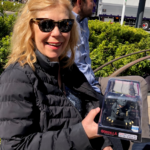Myanmar Adventures
In March, the beginning of the hot summer season, I had the opportunity to visit exotic Myanmar, a place which has always sparked something in my imagination. Tucked away between Thailand, China, India and Bangladesh, the country has the Andaman Sea on one coast, the Bay of Bengal on the other. Myanmar has not changed much since British colonial times – men and women dress in traditional longyi (sarong skirts) and villages have not changed in years. You’ll find no ATM’s here yet, and credit cards are only accepted at major hotels. Internet service is spotty and cell service even less available. Now that Aung San Suu Kyi has been elected to hold a seat in government, hopefully the sanctions against trade with Myanmar will be lifted.
We flew to Bangkok, spent a couple of nights there, then took a short 1 hour 20 minute flight to Yangon, formerly Rangoon. We started out at the Governor’s Residence, our hotel in Yangon. A teak colonial style mansion, with lovely gardens, the hotel is a retreat within the city. We dined on the lawn next to koi ponds and alongside a swimming pool with dark blue-green tiles so the color matched the ponds. Asian style umbrellas by the lounge chairs set around the pool were a nice touch. There is a business center with several computers for guests to use. Rooms were comfortable and attractive.
The city tour took us past colonial mansions and buildings built when the British were here, into the busy downtown area filled with street vendors selling everything imaginable. Traffic was intense, cars and buses filled to the brim. Side by side were blocks of aging, discolored buildings next to new and attractive ones. The country is 85% Buddhist, the rest mostly Hindu, with a few Christians, and a very small Jewish population. There is a synagogue in Yangon, but only 8 Jews! (they have friends.)
The most impressive sight to see in Yangon is the Shwedagon Paya. Our guide arranged for us to be there for sunset, when the gold domes shine with a special glow. Schwedagon is a complex of temples, pagodas, stupas, statues, shrines, pavilions, all centered around the main huge gold stupa in the center. Most of these are covered in either gold leaf or gold paint. At the very top of the main stupa, there is a single 76 carat diamond. The place is amazing to see, especially at sunset then the light makes it almost unearthly. Monks are everywhere, as are locals and tourists. No shoes or socks are allowed to be worn in any temple – feet must be completely uncovered. However, shoulders and knees must be covered, despite the heat!
People in Myanmar were just as curious about us as we were about them. They often stared, and most were ok with us taking pictures. (When asked, most nodded and smiled, only a few declined.) I saw no real poverty or undernourished people. Monks must be given food by local people, the food they don’t eat they give to anyone who is in need. Those people can go to the monastery to get fed. People give food to monks as it gives them a “benefit” in their spiritual life. Many boys become novitiates and spend a week or so in the monastery, studying and living the life of a monk. Many return as adults and enter monastic life.
We flew about an hour to Bagan, where we would board The Road to Mandalay, the ship owned and operated by Belmond. This became our floating hotel for the next 4 days. Arriving in Bagan was magical – everywhere we looked we saw temples, pagodas, stupas – most made of brick, a few painted with gold. There are over 3000 temples scattered across the plains – an incredible sight.
We checked into our cabins on the Road to Mandalay. Since we arrived during a very rare occurence, the water level in the river was too low to navigate, it was decided we would stay in one place and each day would explore from our base in Bagan.
I was always happy to return to our luxurious and thankfully air conditioned boat each day. We were well taken care of, and the boat offered excellent food with both Asian and Western choices, nice size cabins, televisions with CNN and swimming pool on the top deck–all the bells and whistles. Of course the main attraction was the destination.
The best time to visit is winter, from November through February.
To find out more about Myanmar, or to plan a trip, reach me through my profile page at Katie Cadar.


